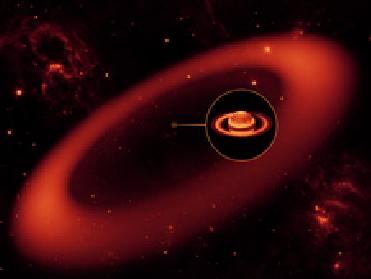
Spitzer Space Telescope has spotted a nearly invisible ring around Saturn - the largest of the giant planet's many rings. Image credit: NASA/JPL
PASADENA (BNS): NASA's Spitzer Space Telescope has discovered an enormous ring around Saturn � so far the largest one of the giant planet's many rings.
The new belt lies at the far reaches of the Saturnian system, with an orbit tilted 27 degrees from the main ring plane. The bulk of its material starts about six million kilometers away from the planet and extends outward roughly another 12 million kilometers. One of Saturn's farthest moons, Phoebe, circles within the newfound ring, and is likely the source of its material, NASA said.
This newest halo of Saturn is thick, with its vertical height about 20 times the diameter of the planet. It would take about one billion Earths stacked together to fill the ring.
�This is one supersised ring,� said Anne Verbiscer, an astronomer at the University of Virginia. �If you could see the ring, it would span the width of two full moons� worth of sky, one on either side of Saturn.�
Verbiscer, along with Douglas Hamilton of the University of Maryland and Michael Skrutskie of the University of Virginia has published their findings in the journal Nature.
The ring itself is tenuous, made up of a thin array of ice and dust particles. Spitzer's infrared eyes managed to spot the glow of the band's cool dust. The telescope, launched in 2003, is currently 107 million kilometers from Earth in orbit around the sun.
This latest discovery may help solve an age-old riddle about one of Saturn's moons � Iapetus. The moon has a strange appearance � its one side is bright and the other is really dark, in a pattern that resembles the yin-yang symbol. Astronomer Giovanni Cassini first spotted the moon in 1671, and years later figured out it has a dark side, now named Cassini Regio in his honour.
The revelation by the Spitzer telescope could explain how Cassini Regio came to be. The ring is circling in the same direction as Phoebe, while Iapetus, the other rings and most of Saturn's moons are all going the opposite way. According to scientists, some of the dark and dusty material from the outer ring moves inward toward Iapetus, slamming the icy moon like bugs on a windshield.
�Astronomers have long suspected that there is a connection between Saturn's outer moon Phoebe and the dark material on Iapetus. This new ring provides convincing evidence of that relationship,� said Hamilton.
 Previous Article
Previous Article Next Article
Next Article












The Indian Air Force, in its flight trials evaluation report submitted before the Defence Ministry l..
view articleAn insight into the Medium Multi-Role Combat Aircraft competition...
view articleSky enthusiasts can now spot the International Space Station (ISS) commanded by Indian-American astr..
view article